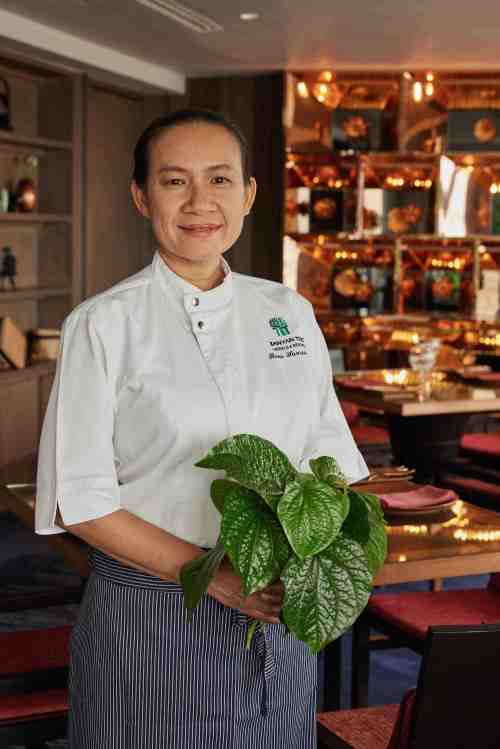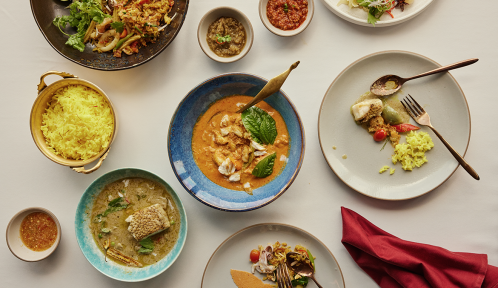Though corporate chef Renu Homsombat has spent the last 20 years working as a professional chef at Banyan Tree’s luxury hotels and resorts, her passion for cooking didn’t start on the line. Rather, it developed as she spent her childhood years in Thailand shadowing the matriarchs in her family. According to Homsombat, these women placed heavy emphasis on the importance of cooking with local, seasonal ingredients and celebrating family traditions.
Experts in This Article
After conversing with Homsombat for just a few minutes, one thing is blatantly clear: To her, a dish is so much more than just ingredients thrown together in a pot. Instead, she considers a recipe a powerful expression of joy and gratitude for life and the land around her.
Today, the highly-successful chef pays homage to her heritage by spearheading the culinary programs at Saffron, Banyan Tree’s flagship restaurant serving top-quality Thai cuisine at 14 locations in eight different countries and hosting an annual Thai Food Festival at several of the resorts, including Banyan Tree Mayakoba, the host property of the event. We sat down with Homsombat, who shared more about her mindful approach to cooking with us, as well as how to create delicious dishes that are as nourishing for the soul as they are for the body.

Why cooking with love and appreciation is, for chef Homsombat, more valuable than salt and pepper
Indeed, some of the most important culinary skills chef Homsombat has learned haven’t come from a chef barking orders in a restaurant kitchen or a strict culinary teacher telling her to chop onions faster. Instead, they were lessons she picked up as a young girl watching her mother and other loved ones going about their regular kitchen tasks—and they’ve been ingrained in her memory ever since. “The story of my love for food and cooking goes back to my childhood. Back in the days when I was around the age of ten, my mother ran a small local food stall. Similarly, my grandmother had a natural talent for cooking,” Homsombat says.
To Homsombat, a dish is so much more than just ingredients thrown together in a pot. Instead, she considers a recipe a powerful expression of joy and gratitude for life and the land around her.
The mother-daughter duo was known for their exquisite culinary skills and ability to bring so much “life and joy” to their family through simple, colorful, and delicious meals. “There was no lavish seasoning, but rather meticulously-chosen ingredients from a backyard or just seasonal ones,” Homsombat says. That said, the main ingredient in everything they made was exactly the same: Passion. “Flavorful dishes reflect your wholesome passion, and the right blend is called ‘flavored love,’” Homsombat says, which she adds is the most important ingredient.
At the heart of every meal Homsombat makes are her grandmother’s words of wisdom: “Each and every step is significant in cooking—from preparing the ingredients to using the appropriate amount of seasoning. We cook for people we love and care about, and seeing a satisfying smile will always warm our hearts.” Indeed, food feeds the body the nutrients to function, but it also nourishes the soul with joy and gratitude. “Beautiful memories of family meals and cooking have resonated with me profoundly, and have continuously inspired me to elevate authentic Thai cuisine to the next level,” Homsombat says.
How Homsombat uses nourishing ingredients to fuel the body
To make food as nourishing for the mind, body, and soul as possible, Homsombat calls upon her roots. “The foundation and soul of Thai cuisine is the use of fresh, local ingredients,” she says. This includes vegetables (like bitter melon and bean sprouts), Thai herbs (like basil, cilantro, lemongrass, kaffir lime leaves, and mint), chilis (like bird’s eye chili), seasonal fruits (like coconut, mango, and mangosteen), and a wide variety of Thai spices (like turmeric, ginger, and cumin).
Many of these Thai ingredients have medicinal properties, too. “For example, bitter vegetables, such as cassia leaves, aid in fever reduction and blood purification. Meanwhile, spicy herbs such as ginger, galangal, and turmeric reduce inflammation, while fingerroot—a type of ginger—helps to strengthen the immune system,” Homsombat says. She incorporates many of these nourishing ingredients together to make some of her favorite dishes, including rich curries like green, crab, roast duck red, and tai pla (made from fermented fish).
Another fundamental staple in Thai cuisine is rice, which also carries important cultural significance for Homsombat. “Rice represents the dedication of hard-working farmers. In Thailand, we grow several different varieties, each with its own unique flavor and health benefits,” Homsombat says. To share this respect for the art of rice making, the chef works with a specialized rice master to serve four varieties at Saffron’s locations.
The most common variety of rice in Thailand is Thai hom mali, aka jasmine rice, which is the pride of the nation, Homsombat says. But they also serve three other kinds: Saffron rice seasoned with antioxidant-rich saffron, which has been part of traditional Thai medicine for centuries; riceberry, which is rich in omega-3 fatty acids; and brown rice, which is high in fiber and omega-3s.
Homsombat uses locally-sourced ingredients whenever possible at Banyan Tree’s different locations. However, to maintain the authenticity of Thai cuisine around the world, she’ll import a few essential components, including lemongrass, galangal, and kaffir lime leaves, when needed to ensure customers enjoy the same high-quality, delicious dishes made with passion and joy the way same she did growing up in her homeland.
A registered dietitian shares the benefits of ginger:
Sign Up for Our Daily Newsletter
Get all the latest in wellness, trends, food, fitness, beauty, and more delivered right to your inbox.
Got it, you've been added to our email list.










